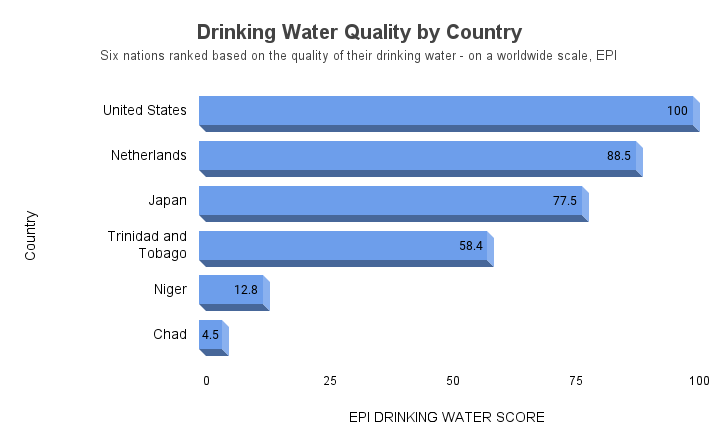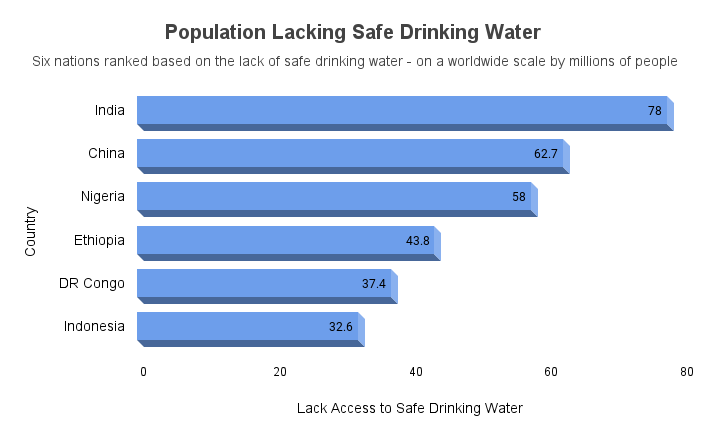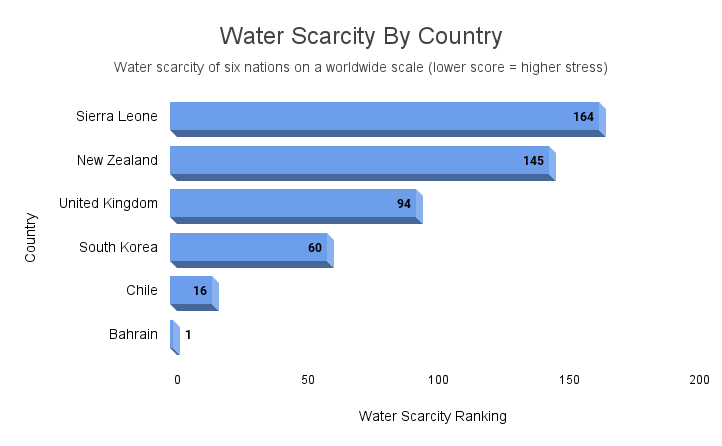- GreenMatch
- Blog
- Global Water Access and Quality 2025
Global Water Access and Quality 2025: Country Rankings and Water Challenges


- Many people around the world still need clean water to drink, with 4.4 billion people lacking safe water services in 2024.
- Some countries, like the United Kingdom, have very clean water, while others, like Niger, struggle with poor water quality at 1.7
- Water stress and scarcity continue to rise, especially in areas with growing populations and climate change impacts.
- Countries are improving water management through cross-border cooperation and technology adoption.
Water, the very foundation of life, is a resource that millions worldwide are struggling to access safely. As of 2025, the global water crisis persists, driven by factors such as population growth, climate change, and poor water management.
It is our collective responsibility to address this crisis and ensure safe water for all. While some countries can safely boast of near-universal coverage, others need help to provide basic water services to large portions of their populations.
This comprehensive analysis will examine the current state of global water access and quality, underscoring key challenges and ranking countries based on various water-related metrics.
We combine and compare data from the Environmental Performance Index (EPI) from Yale University, the World Bank, the World Population Review, UNESCO and UN-Water.

The methodology involved a comparative approach, focusing on disparities between nations and identifying key challenges in water management.
- Water Quality: Assessed using EPI scores ranging from 0 to 100.
- Freshwater Availability: Measured in cubic meters per capita annually.
- Safe Drinking Water Access: Determined the percentage of the population with access to clean water.
- Water Stress Levels: Evaluated based on the percentage of renewable water resources utilised.
Water Quality Rankings
Water quality shows a stark contrast from one country to another. In some places, you can drink the water straight from a mountain stream; in others, it wouldn't be safe even when treated.
And in those places where the quality of water itself is a problem, you see much more pronounced poverty.

The Environmental Performance Index (EPI) provides a comprehensive assessment of water quality worldwide on a scale from 0 to 100, which represents the condition of their water quality. The EPI assesses the quality of water by calculating the "DALY rate," which means the number of disability-adjusted life years lost per 100,000 individuals due to exposure to contaminated drinking water.
The disability-adjusted life years lost simply here mean someone acquires a waterborne disease at the age of 30 as a result of consuming contaminated drinking water. This disease results in them experiencing decreased health for five years before causing them to pass away ten years sooner than anticipated. In this instance:
- YLD lasts for 5 years (with diminished health conditions).
- YLL = 10 years (dying before the expected age)
- The Sum of Disability-Adjusted Life Years is equal to 15 years.
In other words, the person lost 15 years of healthy life due to contaminated water. By using DALYs, the EPI can measure both the deaths and the poor quality of life caused by water-related health issues. This shows a more complete picture of the overall health effects of bad water.
While water quality issues affect many nations, the severity varies significantly across the globe.
The ranking is a mixture of nations globally in terms of water quality, which shows countries are taking the health of their citizens seriously. The United States, for example, is the champion of clean water, with a perfect 100 score for water quality. Italy and Singapore are close behind. But in countries like Niger and Chad, water quality is a severe problem.
Water quality makes a very loud statement about the difference between developed and underdeveloped countries. The developed world generally enjoys a good standard of maintenance and a manageable set of regulations that keep water clean.
Most of the poor places that have water problems either need to pay more attention to upkeep because of a lack of money or have too many people living in a part of the water system that can't handle the load.
Fresh Water Availability
Water, in its pure form, is essential for drinking, agriculture, and industrial activities. Across our globe, this invaluable water is distributed sparingly. Some nations enjoy a generous supply while others grapple with a significant lack.

Nations like Canada, Russia, and Brazil are blessed with vast amounts of water resources. However, several Middle Eastern and North African territories need drastic shortfalls.
According to World Bank data, Brazil is among the top, with 5.7 cubic meters (m³) available to each individual every year; Russia follows closely behind at 4.3 cubic meters (m³), and Canada has 2.9 cubic meters (m³). On the flip side lies Qatar, where merely 56 cubic meters can be allotted per inhabitant annually. This starkly underscores the severe strain on water access in specific locales.
The ever-shifting climate patterns bring more obstacles to ensuring sufficient water is accessible worldwide. Rainfall habits morphing unpredictably, and ice sheets dissolving alongside increasing heatwaves transform known sources into uncertain supplies that complicate planning for those managing our most critical resource.
Safe Drinking Water Access
Clean, safe drinking water is essential to the public's health and should be a basic human right. In most developed and industrialised countries, the right to safe water is taken for granted; it is something we rarely think about.
However, across the globe, the World Health Organization (WHO and UNICEF Joint Monitoring Programme) says that people still lack access to safely managed drinking water services worldwide. A recent study reveals that 4.4 billion people in low and middle-income countries lack access to safe drinking water, more than double previous estimates.

Country-Specific Data
The disparity in access to safe drinking water is stark when comparing different nations:
- High-Income Countries: Singapore, New Zealand, and the United Kingdom maintain 100% access to safe drinking water.
- Low-Income Countries: Papua New Guinea, Madagascar, and the Democratic Republic of Congo face significant challenges.
- In Papua New Guinea, 60% of the population (5.9 million citizens) lacks access to microbial contamination-free drinking water.
- Madagascar's situation is particularly critical, with only 22.24% of the population having access to clean water as of 2022.
- The Democratic Republic of Congo reports that 47.6% of its population lacks access to safe drinking water.
Sub-Saharan Africa faces severe challenges, with only 31.99% of the population having access to clean water. While there has been a slight increase in access over the years, progress still needs to be faster.
Water Stress Levels by Country
When the thirst for water surpasses what nature can provide, that's when water stress takes centre stage. Some countries across the globe need help with this challenge, often fueled by scant resources, crowded populations, and fervent farming or manufacturing activities. The issue is pervasive and pressing.
Besides, countries that find themselves in this range of thirst intensity are classified by the World Resources Institute (WRI). Their tool, “Aqueduct Water Risk Atlas”, offers fresh insights into these pressing challenges worldwide. This platform serves as an invaluable resource for understanding where strain on water supplies looms largest.

Countries that experience this often withdraw about 80% of their available freshwater resources annually.
- Qatar: With extremely high water stress, Qatar relies on desalination for 99% of its water supply due to low rainfall and high domestic consumption (500L/capita/day).
- Israel: Ranked as the second-most water-stressed country globally, Israel uses over 80% of its renewable water supply, making it critically vulnerable to drought and climate change.
- Lebanon: Facing one of the highest levels of water stress worldwide, with over 71% of the population experiencing critical shortages. It's ranked third globally for water scarcity.
- Kuwait: Extremely water-stressed, Kuwait depends on desalination for 99% of its water supply, with an average rainfall of only 115 mm/year.
- United Arab Emirates: Experiencing extremely high water stress, the UAE uses over 80% of its renewable water supply annually, driven by rapid population growth and an arid climate.
On the flip side, countries like Papua New Guinea, Iceland, Sierra Leone and Rwanda have plenty of water compared to what they use.
The story of water stress is intertwined with changing climates, increasing human populations, and developing methods of managing this valuable resource. Keeping tabs on developments and ensuring data stays fresh are key to painting an accurate picture and finding feasible ways forward to address such matters efficiently.
Countries Facing Water Scarcity
Water scarcity stands as a pressing concern all over the world, affecting both developing and developed nations.
Countries dealing with water shortages are confronted with complex problems. The 2024 UN-Water evaluation reveals that global climate changes are profoundly affecting water movement patterns, resulting in more frequent and intense dry periods. For nations with scarce water resources, this means increasingly unpredictable and diminished water supplies.

Multiple factors contribute to this crisis:
- Climate shifts leading to altered precipitation patterns
- Burgeoning population numbers increasing water demand
- Substandard water management systems exacerbating shortages
The financial repercussions of limited water access are significant. The WRI estimates that some regions could see their GDP decline by up to 6% by 2050 due to water-related losses. This pinpoints the pressing requirement for these countries to tackle such hurdles effectively.
The same can be said about many other parts of the world as it has pressing issues, particularly in Asia and Africa, where population growth and upstream dam projects are exacerbating the problem.
In South Asia, India faces a significant challenge, with 18% of the global population but access to only 4% of the planet's freshwater resources. Neighbouring Pakistan, while making some progress in water management, still struggles with water stress, according to experts.
The situation is equally concerning in the Middle East and North Africa. Egypt, heavily dependent on the Nile River, is increasingly threatened by dam projects upstream. Similarly, Iraq is grappling with water shortages due to dams constructed in neighbouring countries.
Even the most advanced nations are free of these difficulties. Even advanced nations also face water challenges. In the United States, western areas, especially California, are experiencing considerable water scarcity.
In April 2024, California's State Water Project allocation rose from 40% to 30%, showing some progress but still underlines persistent water issues in the area. Australia continues to face ongoing challenges with repeated droughts and the effects of climate change. Water scarcity is a common occurrence in the southern regions of Spain.
Countries need to collaborate more in order to discover viable strategies for managing and conserving water sustainably.
Addressing Global Water Challenges
Shared waters don't recognise human boundaries, often traversing through multiple nations. Collaborating on cross-border water management is vital for mutual benefit.
Initiatives like the Nile Basin Cooperation strive to guarantee equitable distribution among nations with common water sources. According to the Global Risks Survey by the World Economic Forum for 2024, "depletion of natural resources" ranks as a top concern in the coming years.
| Metric | Global Average | Best Performing Country | Worst Performing Country |
|---|---|---|---|
| Population with access to safe drinking water | 74% | 100% (Several) | 38% (Chad) |
| Water quality index (0-100) | 65 | 100 (United Kingdom) | 1.7 (Niger) |
| Renewable internal freshwater resources per capita (m³) | 5,925 | 519,265 (Iceland) | 3 (Bahrain) |
| Water stress level (%) | 17% | <1% (Congo) | 472% (Qatar) |
| Population affected by water scarcity | 40% | <1% (Iceland) | >80% (Yemen) |
However, tackling the worldwide water crisis calls for diverse strategies and actions.
- Improved Water Management: Implementing efficient irrigation techniques and reducing water waste.
- Infrastructure Investment: Upgrading water treatment facilities and distribution networks.
- Technology Adoption: Employing smart water sensors and desalination technologies.
- Policy Changes: Enacting stricter regulations on water use and pollution.
- International Cooperation: Collaborating on transboundary water management.
Investing in water systems and oversight can bring significant financial gains. The United Nations estimates that for every £1 invested in clean water and hygiene, there’s a £4.30 gain from boosted efficiency and lower medical expenses.
Moreover, not having enough clean water leads to serious health issues. Illnesses spread by dirty water result in roughly 485,000 deaths from diarrhoea each year, primarily impacting young kids in poorer nations.
Solving worldwide water problems also means changing the way people and companies treat this vital resource. Campaigns can inform the public about more effective home water meters that reduce water bills and waste. Another way to cut back on water waste is through water farming methods like rainwater collection.
Sanitation & Drinking Water
The category of Sanitation & Drinking Water assesses the extent to which nations safeguard health by addressing hazards focusing on two key indicators. The safety of drinking water and sanitation facilities.
10 Things You May Not Know About Global Water Access
- As of 2024, 27% of the world's population lacks access to safely managed drinking water. This translates to 4.4 billion people without safe water services. By 2025, 1.8 billion people will face absolute water scarcity.
- Globally, agriculture accounts for 70% of freshwater withdrawals. Industry uses 20%, while domestic use comprises 12%. This high consumption raises concerns about sustainable water management and food security.
- Since 1980, global freshwater demand has grown by 1% annually. By 2030, an estimated 4 billion people will live in areas of high water stress.
- Changing rainfall patterns, melting glaciers, and more frequent droughts intensify water scarcity. These factors threaten water security worldwide.
- Water deficits caused a 10% increase in global migration between 1970 and 2000. Future water shortages may displace millions more.
- Water-related disasters cause significant economic losses. From 2002-2021, floods caused nearly 100,000 deaths and £664 billion in economic losses. Droughts affected 1.4 billion people in the same period.
- Groundwater supplies 25% of all water used for irrigation and 50% of domestic freshwater. This vital resource faces increasing pressure.
- Glaciers melted faster in 2023 than they have in 50 years. This trend threatens long-term water security for millions.
- The year 2023 was the driest for global rivers in 33 years. Climate change continues to make the hydrological cycle more erratic.
- A child dies every minute from preventable water-related illnesses. Diarrhoea remains the second leading cause of death for children under five.
Final Thoughts
In the global scene, the water dilemma is a tough puzzle needing swift teamwork. While there's progress exists in some places, millions still face the hurdle of reaching clean water. The pressure on this vital resource keeps mounting across various areas. Tackling these hurdles calls for inventive technology, policy changes, and worldwide teamwork.
When we look at how we've been managing our planet's water this 2025, it's clear that having enough water is a big deal. It's connected to things like long-term growth, healthy communities, and even political stability.
By focusing on improving how people get their share of safe water and its purity, we aim for a fairer future where everyone stands strong together.

Inemesit is a seasoned content writer with 9 years of experience in B2B and B2C. Her expertise in sustainability and green technologies guides readers towards eco-friendly choices, significantly contributing to the field of renewable energy and environmental sustainability.
We strive to connect our customers with the right product and supplier. Would you like to be part of GreenMatch?

